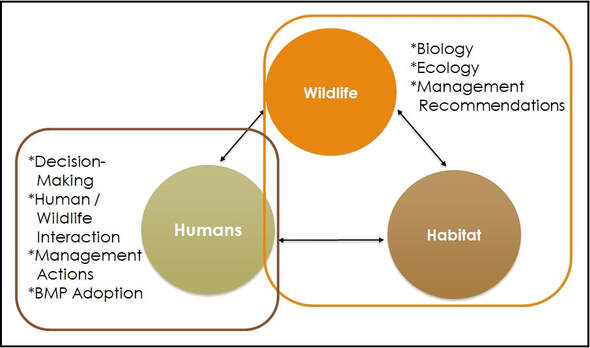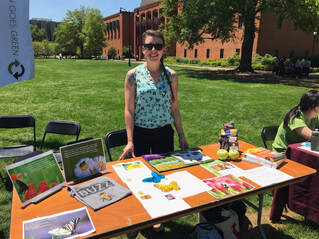
Guest Blog By Shannon M. Westlake, PhD, Mississippi State University
Human Dimensions of Pollinator Conservation
When someone says the buzz phrase “pollinator conservation” what is the first thing that comes to mind? Bees? Butterflies? Beetles? What about humans? The term “human” in this context may have negative connotations relating to habitat destruction or increased chemical use. While humans have contributed to pollinator decline, they also have a very important role to play in pollinator conservation.
Researchers investigating the human dimensions of conservation or natural resource management seek to understand how people value wildlife or natural resources, how people believe those resources should be managed, and how people affect or are affected by them and associated management decisions.

The majority of native pollinator research efforts have focused on pollinator biology and ecology, rather than the sociology behind how people perceive and value pollinators. With my dissertation research, I aimed to study social aspects by investigating landholder attributes that affect their decisions of whether or not to adopt pollinator best management practices (BMPs), including using cover crops, creating field borders, and using targeted herbicides.
|
For this study, I developed a mail survey that was sent to Mississippi landholders to investigate their attitudes, knowledge, social pressures, perceived constraints, and intentions to adopt pollinator BMPs. Individuals owning or renting 25 acres or more in Mississippi were eligible for the study. I used various grouping techniques to determine landholder similarities and differences to assist in the development of targeted educational and outreach recommendations.
|
 |
Over 1,400 landholders responded to the survey, with many interested in learning more about pollinator conservation and BMPs. The majority of landholders had adopted at least one pollinator BMP. Most landholders had more favorable than unfavorable attitudes toward the practices and some felt social pressures from others to use them. The primary influence on landholders’ intentions to adopt pollinator BMPs were their perceived constraints including adequate time, resources, and knowledge. Even if landholders have favorable attitudes and feel social pressure to adopt these pollinator BMPs, they still need to feel like they have the time, resources, and skills to actually use them.
Although the majority of landholders had previously adopted pollinator BMPs, many still reported they did not have adequate knowledge to use them. While awareness of pollinator declines continues to rise, knowledge of how to implement practices to protect these important invertebrates has not kept pace.
Through the grouping techniques, I was able to determine that those who were more familiar with the BMPs (i.e., Current Adopters who were using the practices at the time of taking the survey) had reported that they were more likely to use them in the future. They also reported greater knowledge, more favorable attitudes, and felt less constrained than those who reported they were no longer using the BMPs or had never adopted any. Agricultural landholders used more BMPs, had greater knowledge, more favorable attitudes, and felt less constrained than timber or non-production landholders.

So what does this all mean? The surveyed landholders used pollinator BMPs to a varying degree, yet their responses indicate that more knowledge cultivation is necessary to increase BMP adoption in the future. Currently, pollinator conservation messaging is broad because there are many ways to get involved and provide support. This lack of specificity in messaging means landholders do not have the knowledge they need to feel comfortable adopting pollinator BMPs. My research indicates that landholders would be better supported through a two-step approach:
|
1) Develop targeted messaging regarding pollinator BMPs that includes information regarding costs, relative advantages, multiple benefits, and implementation specifics.
2) Provide more hands-on opportunities such as workshops where landholders can observe BMP demonstration areas, practice skills, and connect with conservation professionals and other landholders. |
 |
Although biological and ecological studies are essential for pollinator conservation, they are only two pieces of the puzzle. Human dimensions research is often overlooked in wildlife projects, yet it is a key component, especially if the goal is to increase the involvement of private landholders. Rural landholders provide a potential wellspring of support that could result in substantial change. We need to harness this interest by further studying human dimensions to provide more targeted support.
Although informative and interesting, my study is only the tip of the iceberg. There is a lot more we can discover about people’s connections to pollinator conservation. Recent studies have shown people’s interest in and support for pollinators, like the National Recreation and Park Association’s online and regional pollinator surveys, which provide further evidence of the need for more targeted support options for private landholders.
Now is the time to change the role of humans in pollinator conservation from problem to solution. By understanding attitudes, social pressures, knowledge, and constraints of private landholders, we can provide more targeted land management recommendations that lead to the adoption of pollinator BMPs and improve habitat connectivity and health.
Shannon recently completed her PhD at Mississippi State University. She is currently helping champion Mississippi State University’s efforts to become a Bee Campus USA.




